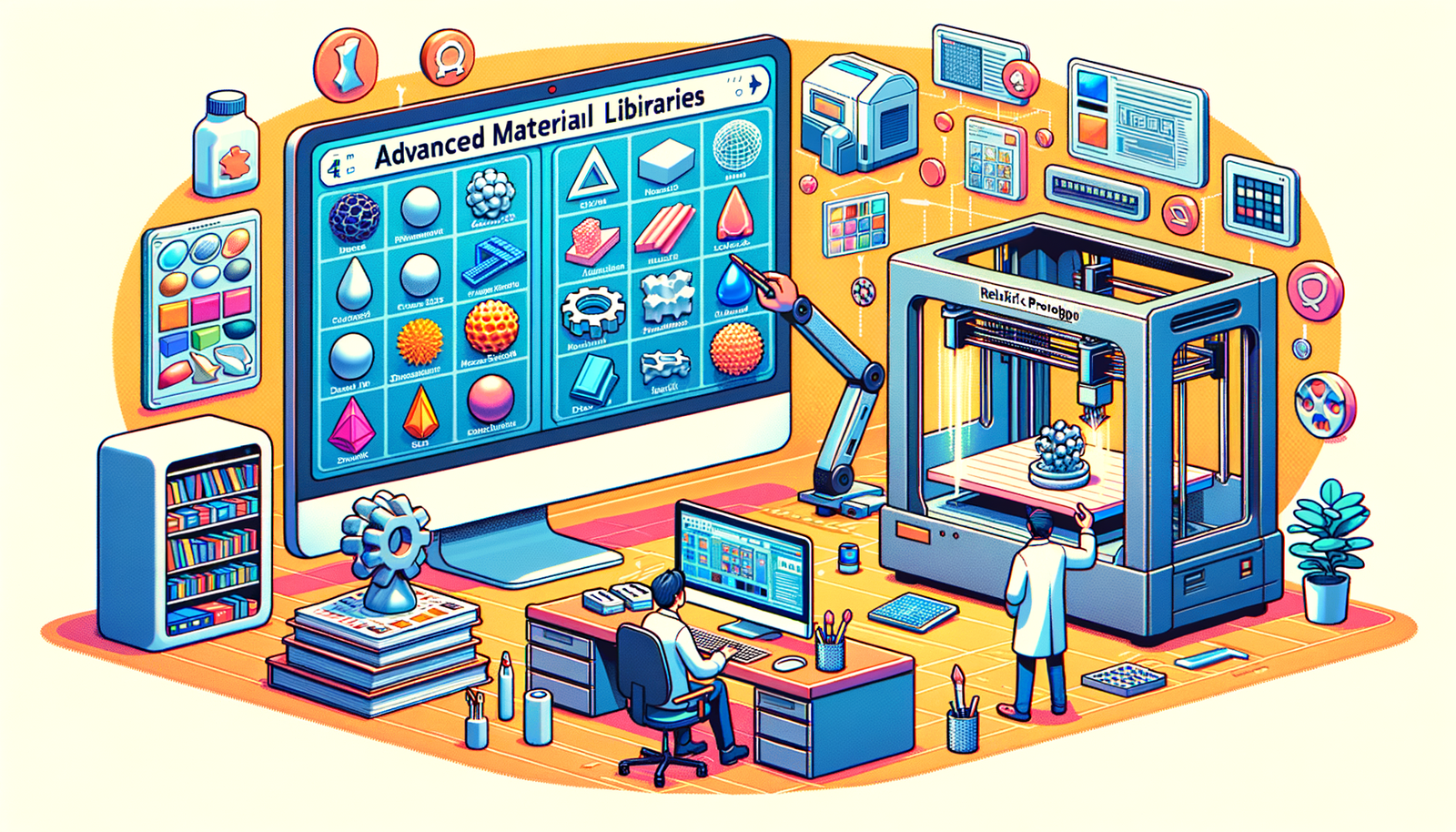Your Cart is Empty
Customer Testimonials
-
"Great customer service. The folks at Novedge were super helpful in navigating a somewhat complicated order including software upgrades and serial numbers in various stages of inactivity. They were friendly and helpful throughout the process.."
Ruben Ruckmark
"Quick & very helpful. We have been using Novedge for years and are very happy with their quick service when we need to make a purchase and excellent support resolving any issues."
Will Woodson
"Scott is the best. He reminds me about subscriptions dates, guides me in the correct direction for updates. He always responds promptly to me. He is literally the reason I continue to work with Novedge and will do so in the future."
Edward Mchugh
"Calvin Lok is “the man”. After my purchase of Sketchup 2021, he called me and provided step-by-step instructions to ease me through difficulties I was having with the setup of my new software."
Mike Borzage
Leveraging Advanced Material Libraries for Realistic Prototyping in Modern Design Workflows
April 20, 2025 12 min read


Advanced Material Libraries in Modern Design
In today's digital era, the evolution of advanced material libraries has fundamentally transformed the way designers and engineers approach product development. These libraries serve as comprehensive databases containing detailed information on material properties, including mechanical, thermal, and chemical characteristics, which are crucial for simulating how products will perform under various conditions. As design software continues to integrate these databases, designers can now anticipate how a material will behave in the real world, reducing the reliance on physical prototypes and thus streamlining the design process. This integration is particularly significant in industries where safety and performance are paramount, such as aerospace and automotive engineering. In effect, the role of sophisticated data structures and algorithms in managing these material libraries is to ensure that each digital simulation closely mirrors reality, particularly when simulating challenging phenomena like stress distribution, fracture mechanics, and thermal expansion. Moreover, the ability to update and expand these libraries in near real-time allows for ongoing innovation and optimization, ensuring that designers always have access to the most relevant and up-to-date data. The concept of realistic prototyping within modern design workflows is propelled by these extensive libraries, which not only provide a robust foundation for simulation but also enable a nuanced understanding of how different materials interact. For instance, mapping out properties with high granularity supports tasks such as optimizing geometries for additive manufacturing, where slight variations in material behavior can lead to significantly different outcomes. Key challenges that designers face often include integrating these libraries into legacy systems, handling the large volume of data, and ensuring data consistency across various simulation platforms. These obstacles necessitate a seamless backend integration combined with an intuitive user interface, so that even non-expert users can leverage complex data. Furthermore, the shift towards digital prototyping has amplified the need for tools that can simulate physical properties with high fidelity, thereby minimizing the errors that costly physical prototyping might introduce. This drive for realism also pushes forward innovations in computational methods and data analytics. The collaboration between material scientists, software developers, and design engineers is critical, as it underpins the continuous improvement of these libraries, ensuring they remain relevant in the light of evolving technological needs and industry standards. As a result, the current landscape of design software is marked by an interplay of data management, simulation accuracy, and ease of use, establishing a new paradigm for material application in industrial design while challenging traditional methodologies.
Realistic Prototyping in Contemporary Workflows
The concept of realistic prototyping has significantly redefined contemporary design workflows by bridging the gap between theoretical models and tangible outcomes. Within modern design environments, this instant transition from digital to physical simulation is not merely about achieving higher levels of precision; it is about harnessing the power of detailed material insights to facilitate innovation and reduce the often extensive iteration cycles seen with conventional prototyping methods. High-fidelity simulations, which are powered by robust material libraries, allow designers to evaluate how products will react to dynamic forces, environmental changes, and real-world usage conditions. This rupture from the conventional trial-and-error approach has led to a more strategic and informed decision-making process, where every design element is underpinned by a rigorous, data-driven evaluation. Realistic prototyping enables a continuous feedback loop between the digital model and the end product, ensuring that ideas can be tested, refined, and validated with unprecedented accuracy. Such a workflow is essential in fields where material performance under stress is critical—for instance, in aerospace engineering tasks where simulations help predict potential failure modes before any real component hitting the production line. Additionally, realistic prototyping bolsters client confidence as detailed, simulation-backed insights provide tangible predictions and outcomes. It is common practice now for design teams to implement a spectrum of simulation tests that cover various failure modes, durability assessments, and environmental impacts. Among the myriad benefits are the following:
- Accelerated product development timelines by reducing reliance on costly, high-fidelity physical prototypes.
- Enhanced prediction accuracy through integrated material databases that offer granular insights into material behavior.
- Streamlined cost management by identifying potential issues early in the design process, thereby avoiding expensive late-stage modifications.
Technical Foundations and Underlying Algorithms
The backbone of effective design software that hosts advanced material libraries relies on sophisticated algorithms and data structures engineered to handle vast repositories of material properties. At the core, these algorithms work by simulating the behavior of materials under various forces, capturing nuances such as elasticity, durability, and thermal response. The digital representation of material properties is achieved through finely tuned numerical methods that translate abstract physical concepts into computable models. In many instances, designers leverage techniques such as finite element analysis (FEA) and computational fluid dynamics (CFD) to predict how materials will perform under stress or when subjected to specific environmental conditions. The algorithms behind these methods are highly optimized to run complex simulations in real time, enabling users to interact with dynamic models that accurately represent the physical performance of prototypes. Moreover, the data structures used to store material properties must be highly scalable and flexible, ensuring that everything from basic properties (like density and tensile strength) to advanced metrics (such as anisotropic behavior and fatigue limits) can be integrated seamlessly into the overall framework of design software. This integration is crucial because it allows the software to provide a user-friendly interface where users can select, modify, and simulate materials without needing to understand the underlying complexity. As such, the algorithms not only drive the simulation engines but also play a key role in ensuring the consistency, accuracy, and usability of the whole system. The layered approach, where basic data structures support more complex simulation routines, is what facilitates the high level of detail required for realistic prototyping. Additionally, these systems often incorporate adaptive algorithms that can refine simulation resolutions on the fly, making it possible to focus computational power where it is most needed during intensive simulations. This not only enhances performance but also provides a more meticulous analysis of how specific regions of a design might behave under catastrophic conditions. In parallel, the continuous development of these algorithms represents one of the most demanding aspects of modern computational engineering, with researchers and software developers working in unison to establish new standards that push the limits of what is digitally feasible in simulating physical properties with unprecedented accuracy.
Developing and Customizing Material Property Databases
The process of developing and customizing material property databases is central to the creation and maintenance of effective advanced material libraries in contemporary design environments. These databases are meticulously compiled and curated, often incorporating data from extensive experimental tests, theoretical studies, and industry standards. The challenge lies in ensuring that this data is not only accurate but also readily available in a format that can be dynamically accessed by design software. Customization plays an essential role in these systems, as different industries—ranging from automotive to consumer electronics—often require specialized datasets tailored to the unique properties of the materials used in their production. Designers and engineers typically have the ability to expand these databases by incorporating new materials or updating existing data as new findings emerge. This flexibility is vital to maintaining a competitive edge, as it allows for continuous innovation based on the latest material science advancements. In the development process, various algorithmic techniques are employed to both validate and normalize data across diverse sources; ensuring uniformity is crucial for simulation accuracy. Moreover, the databases are built using data structures that are optimized for high-speed read and write operations, ensuring that simulations can proceed without bottlenecks. The customization process is often driven by modular frameworks, where individual material properties can be swapped in and out to observe changes in performance metrics. Some of the most important aspects to consider during customization include:
- The accuracy and reliability of experimental data that feeds into the database.
- The compatibility of different data formats and their seamless integration into the software.
- The scalability of the database infrastructure to accommodate future growth and increased simulation demands.
Leveraging Advanced Material Libraries for Design Excellence
The practical application of advanced material libraries in design software has opened up an expansive frontier for achieving design excellence. Designers today are not only required to conceptualize innovative products but also to ensure that these products can withstand real-world challenges. The integration of robust material property databases into design workflows allows for detailed simulations that capture every nuance of material behavior. This approach directly influences the effectiveness of realistic prototyping by offering a virtual testbed where multiple variables are considered simultaneously. By simulating how materials behave under different conditions—be it mechanical stresses, thermal cycles, or even chemical reactions—designers can preemptively identify potential issues and address them before advancing to the manufacturing stage. The application of these libraries is particularly transformative in sectors that are highly competitive and conservative in their approach to innovation, such as aerospace, automotive manufacturing, and consumer electronics. In these fields, every minor improvement in simulation accuracy can translate into significant benefits in terms of product performance, safety margins, and operational efficiencies. The workflow typically leverages several key best practices that have emerged over time:
- Regular updates and validations of material data to ensure simulation fidelity.
- Integration with real-time sensor data to recalibrate virtual models continuously.
- Cross-collaboration among material scientists, computational engineers, and designers to maintain a holistic view of the design process.
Overcoming Challenges in Integrating Material Libraries
Despite the transformative potential of advanced material libraries, integrating these sophisticated tools into existing design workflows presents a series of challenges that require careful navigation. Designers often encounter hurdles in terms of interoperability between various software platforms, each with its own standards and protocols. Ensuring that material databases can communicate seamlessly with simulation engines and rendering tools is critical to maintaining the accuracy of realistic prototyping efforts. One significant challenge is the harmonization of data formats; disparate sources of material data must be reconciled to create a consistent and reliable repository. In addition, the constant updates and customizations demanded by evolving material science research require flexible integration techniques that allow new data to be incorporated without disrupting established workflows. To achieve this, many design teams have adopted modular integration strategies, where the material library acts as an independent module that can interface effortlessly with various components of the design process. Key strategies to address these challenges include:
- Implementing standardized data exchange protocols to bridge different software environments.
- Employing middleware solutions that can serve as a translator between legacy systems and modern simulation engines.
- Conducting regular system audits and calibrations to verify data integrity and simulation accuracy.
Emerging Trends and Innovations in Design Software
As the landscape of product development evolves, emerging trends in design software are continuously reshaping the way designers interact with advanced material libraries and approach realistic prototyping. One of the most significant trends is the emphasis on higher fidelity simulations, where even the minutest details of material behavior are replicated digitally through advanced computational models. Innovations in machine learning and artificial intelligence are beginning to play a pivotal role in optimizing simulation processes. These technologies are capable of identifying complex patterns and predicting material responses under atypical conditions, thereby enhancing both the reliability and the efficiency of the design workflow. Furthermore, the convergence of augmented reality (AR) and virtual reality (VR) tools with traditional design software is opening new avenues for interactive and immersive prototyping. Designers can now manipulate digital models in a simulated three-dimensional space, offering a more intuitive way to assess material interactions and performance under varied scenarios. This integration of high-tech visualization with detailed material data not only boosts creativity but also improves communication among interdisciplinary teams. To better illustrate these innovations, consider the following emerging directions in design software:
- AI-Enhanced Simulation Tools: Algorithms that learn from previous simulations to refine future predictions.
- Immersive Prototyping Environments: AR and VR platforms that allow real-time engagement with digital prototypes.
- Cloud-Based Material Databases: Centralized repositories accessible from various devices and locations.
A Call to Action for the Future of Design and Prototyping
In conclusion, the transformative impact of advanced material libraries on the process of realistic prototyping within modern design workflows cannot be overstated. As organizations continue to push the boundaries of what is digitally possible, it becomes imperative for designers and engineers to embrace emerging trends and contribute actively to the evolution of design software. The transition from physical testing to high-fidelity digital simulations has not only paved the way for more efficient and predictive design processes but has also ushered in a new era of innovation and creativity. Practitioners are now empowered with tools that allow them to simulate complex physical phenomena with unmatched accuracy, thus reducing prototyping cycles, cutting down on development costs, and ultimately generating products that are both reliable and groundbreaking. This convergence of detailed material databases, robust computational techniques, and intuitive user interfaces has redefined traditional product development paradigms, urging a collaborative synergy among material scientists, software developers, and design engineers. Looking ahead, the continued integration of artificial intelligence, cloud-based collaboration platforms, and immersive visualization technologies promises to further refine and enhance this dynamic ecosystem. Designers are encouraged to not only adopt these advanced tools but also participate in expanding and refining the standards that underpin them. By doing so, they contribute to a collective journey towards improved simulation accuracy, greater design reliability, and ultimately, the realization of projects that harmonize aesthetic vision with functional excellence. The ongoing dialogue between practical design challenges and emerging digital innovations ensures that every iteration brings with it an opportunity for learning and progress. It is now more than ever that a call to action resonates across the engineering and design communities: to embrace these digital tools wholeheartedly, to share expertise, and to foster an environment where continuous improvement is the norm. In the spirit of innovation and quality, the future of design and prototyping depends on our collective commitment to excellence, collaboration, and the relentless pursuit of precision in every micro-detail of our digital models.
Also in Design News

ZBrush Tip: Enhancing ZBrush Workflow Efficiency with Polygroups Techniques
April 20, 2025 2 min read
Read More
Revit Tip: Optimizing BIM Workflows: Key Strategies for Integrating Revit and Navisworks
April 20, 2025 2 min read
Read More
AutoCAD Tip: Enhance AutoCAD Drawings with Effective Annotation Scaling Techniques
April 20, 2025 2 min read
Read MoreSubscribe
Sign up to get the latest on sales, new releases and more …


